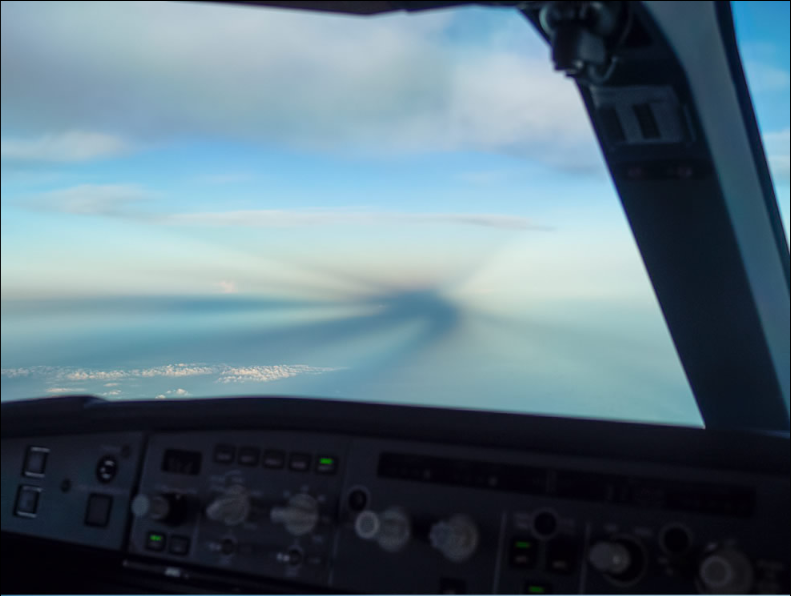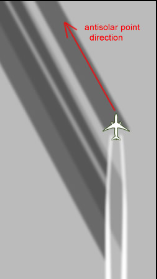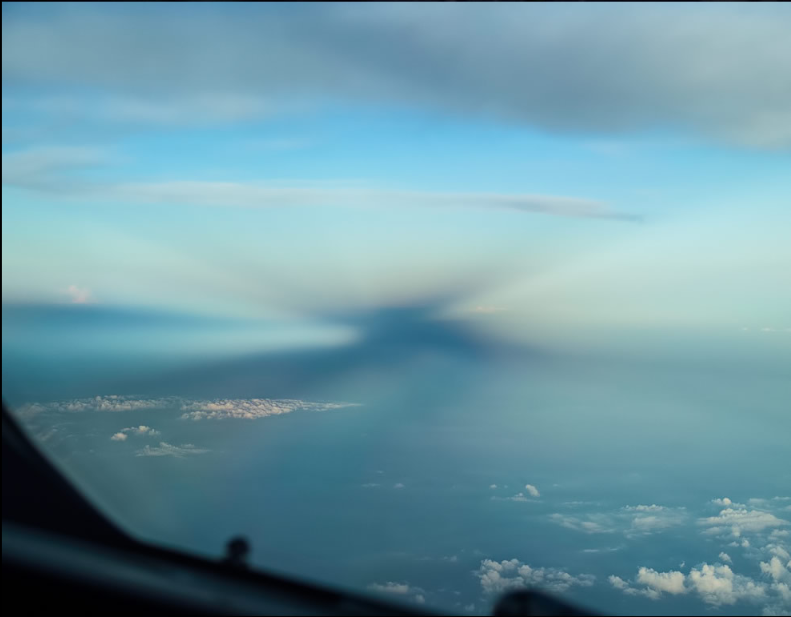Antisolar Oddities, Curved Contrail Shadows - OPOD
Antisolar Oddities: The Curious Phenomenon of Curved Contrail Shadows
Have you ever witnessed a peculiar sight in the sky that left you questioning the laws of physics? Peter Ross captured such an enigmatic moment when he observed a striking display of antisolar oddities. In this article, we will delve into the fascinating world of atmospheric optics and explore the mystery behind curved contrail shadows.
As Ross's photograph reveals, the sun was positioned low, lurking behind and to the right of the aircraft. At the heart of this atmospheric spectacle lies the antisolar point, directly opposite the sun and approximately 30-45° to the left of the plane's heading.
Gazing upwards from the antisolar point, we encounter a familiar phenomenon known as anticrepuscular rays. But why are these shadows referred to as rays? It's because they are cast by clouds positioned higher than the aircraft, scattered throughout the sky. Although appearing to converge with distance, these rays are actually parallel to one another.
However, what truly captivates our attention are the dark and curved shapes that adorn the sky. These intriguing formations are, in fact, shadows. But shadows from what, and why are they curved?
The answer lies in the contrails being generated by the aircraft. Contrails, short for "condensation trails," emerge as a result of water vapor condensing around the aircraft's exhaust particles. As the sun illuminates the scene from the right, the contrail shadows project through the sky ahead of the plane and to its left.
But what causes these contrail shadows to assume their distinctive curved shape? On many aircraft, the airflow and engine nacelle angle induce contrails to initially curve downwards before leveling out. This unique trajectory contributes to the peculiar shadow shapes we observe, particularly in the case of the right-hand shadow that appears to originate from below the airplane.
Now that we have unraveled the mystery behind curved contrail shadows, let's take a closer look at the visual evidence captured by Peter Ross. The accompanying images provide a captivating glimpse into this atmospheric phenomenon.
In the first image, we witness the remarkable interplay between the sun, the aircraft, and the antisolar point. The positioning of these elements creates a mesmerizing display of shadows and rays, casting an ethereal ambiance upon the sky.
In the subsequent images, we are presented with a more detailed view of the contrail shadows themselves. These close-ups allow us to appreciate the subtle nuances and curvature that define these shadowy formations. It's a testament to the intricate interplay between light, clouds, and aircraft that gives rise to such visually stunning atmospheric phenomena.
As we conclude our exploration of antisolar oddities and curved contrail shadows, it is important to remember that atmospheric optics continually offers new and captivating wonders for us to unravel. The more we observe and study these phenomena, the deeper our understanding becomes of the intricate mechanisms at play in our atmosphere.
So, next time you find yourself gazing up at the sky, keep an eye out for these intriguing atmospheric displays. Who knows what mysteries you may uncover within the ever-changing canvas above us?

Antisolar Oddities
Peter Ross captured this strange sight.
The sun was low, behind and to the right of the aircraft. The antisolar point, directly opposite the sun, is at image centre and 30-45° left of the plane's heading.
Upwards from the antisolar point are familiar anticrepuscular (antisolar) rays. Why do we call shadows, rays? Clouds cast these shadows. Clouds higher than the aircraft but otherwise anywhere in the sky. One ray from a lower altitude cloud streams inwards from the right. The rays are all parallel. They only appear to converge with distance.
The dark and curved shapes are more puzzling. They are shadows. From what? And why curved?
The aircraft is making contrails. Their shadows project through the sky ahead of the plane and to its left because the sun is shining from the right. On the flight deck they stream from the left towards the antisolar point.

Why curved? On many aircraft the airflow and engine nacelle angle induce contrails to initially curve downwards before levelling out. This helps give the peculiar shadow shapes, especially to the right-hand one coming in from below the airplane.


Note: this article has been automatically converted from the old site and may not appear as intended. You can find the original article here.
Reference Atmospheric Optics
If you use any of the definitions, information, or data presented on Atmospheric Optics, please copy the link or reference below to properly credit us as the reference source. Thank you!
-
<a href="https://atoptics.co.uk/blog/antisolar-oddities-curved-contrail-shadows-opod/">Antisolar Oddities, Curved Contrail Shadows - OPOD</a>
-
"Antisolar Oddities, Curved Contrail Shadows - OPOD". Atmospheric Optics. Accessed on November 26, 2024. https://atoptics.co.uk/blog/antisolar-oddities-curved-contrail-shadows-opod/.
-
"Antisolar Oddities, Curved Contrail Shadows - OPOD". Atmospheric Optics, https://atoptics.co.uk/blog/antisolar-oddities-curved-contrail-shadows-opod/. Accessed 26 November, 2024
-
Antisolar Oddities, Curved Contrail Shadows - OPOD. Atmospheric Optics. Retrieved from https://atoptics.co.uk/blog/antisolar-oddities-curved-contrail-shadows-opod/.